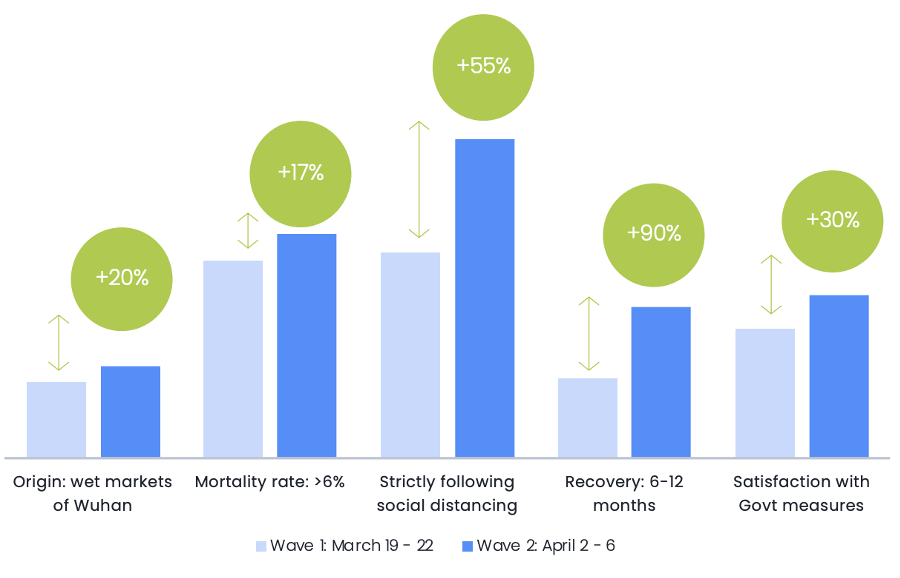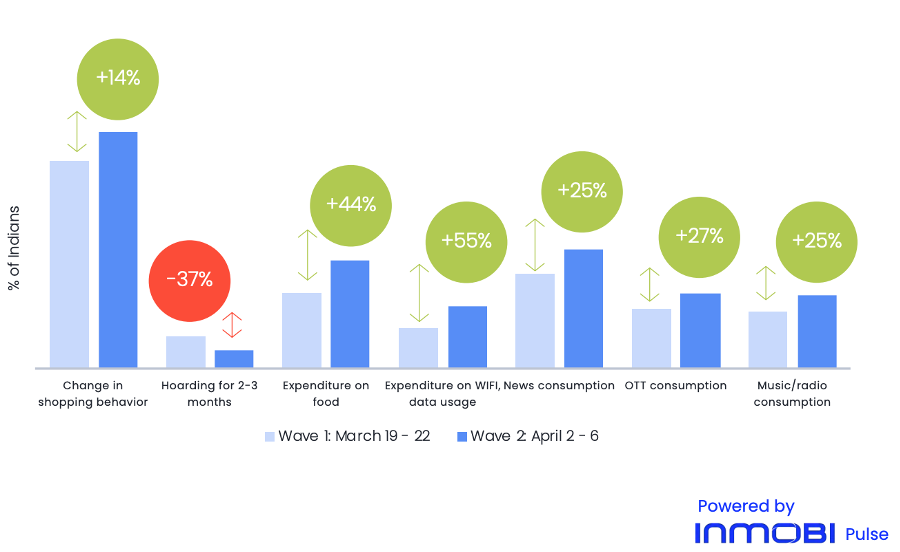- Media Consumption & Trends
- Understanding Consumers
The Shift in the Indian Consumer Behavior Since Lockdown

Novel Coronavirus cases spreading across the nation have brought several noticeable changes in the way Indians think, shop, interact and live. We at InMobi took a deep dive into the shift in consumer behaviour using our Mobile Market Research Platform. The survey was conducted from April 2 to 6 with a sample size of 3116 smartphone users across India.
The Overall Consumer Sentiment About the Coronavirus
While awareness of the actual origin of coronavirus has increased by 4 percent, misinformation continues to abound, leaving Indians in a state of confusion. Measures taken by the government to contain the spread of the virus including the 21-day lockdown, the ban on international travel, and halting interstate transportation are all appreciated by the Indians in the respective order.

40 percent of Indians believe that it will take the world between 6-12 months to get rid of Coronavirus. This is a 90 percent increase since the last survey held before the lockdown. 69 percent of the Indians are concerned about the impact on migrant laborers/daily wage earners and the underprivileged class.
The Shift in Shopping and Media Consumption
There has been a dynamic shift in the way Indians shopped in just one and a half weeks. 14 percent of Indians have changed their shopping behavior of stocking up groceries and household essentials. With fewer folks hoarding items or buying in bulk, others continue to have access to the daily essentials.

With everyone sheltered at home, expenditure on food and WIFI/mobile data usage has seen a dramatic increase resulting in increased consumption of news, OTT content, and music.
The Impact of the Pandemic on Gen Z
Young Indians in the age group of 14 – 24, of which 57 percent are currently still pursuing their education, belong to the Gen Z category. Only 10 percent of them live alone/with friends. 90 percent of them live with their families and have minimal responsibilities towards their home. They have a lot of time on their hands and are keeping themselves engaged.
Gen Z State of Mind and Outlook
79 percent Are following social distancing measures. This is 9 percent lower than the average respondent
74 percent are feeling negative emotions such as sadness, fear, disgust, and anger
75 percent are unaware of the origins of the virus two weeks into the lockdown
67 percent feel that the pandemic will subside either in 2 to 3 months or in 6 to 12 months
41 percent are worried about the impact on the coronavirus on their education
28 percent Feel confused about their future after COVID-19 and have a bleak outlook
Gen Z Lifestyle and Spending Habits
67 percent are seeing an increase in their budgeted expenditure on key categories
Gen Z are the biggest spenders with 26 percent of them upgrading on the WIFI and data usage on their smartphones
56 percent of Gen Z prefer to buy for less than a week, especially when it comes to groceries and household essentials
20 percent of Gen Z is spending on personal care products compared to 15 percent from Gen X
11 percent are picking up a new skill or brushing up old skills. They are also twice as likely to do so than other age groups
Gen Z Media Consumption Trends
41 percent of Gen Z are consuming news, 35 percent are playing games while 31 percent are active on social media
33 percent are listening to music, 26 percent are actively watching content on OTT platforms while 14 percent are consuming audiobooks/podcasts
The Impact of COVID-19 on Millennials
Young Indians who are in the age group of 25 – 34, of whom 60percent are married, 87 percent live with their families and 50 percent earn above INR 30,000 per month. These folks have relatively more responsibilities and are likely to spend time with their families. They are also tech savvy and rely on technology to get their work done, remain informed and entertained.
Millennials State of mind and Outlook
88 percent Are strictly following social distancing measures, with 50 percent following sanitation measures
81 percent are feeling negative emotions while fear stands as the dominating emotion with 35 percent feeling it. Millennials are also feeling sadness, anger and disgust.
45 percent of millennials feel that the pandemic will subside in 6-12 months
40 percent are worried about the impact of coronavirus on their financial health
28 percent Have an optimistic outlook about the future after COVID-19 subsides
Millennials Lifestyle and Spending Habits
42 percent of millennials are spending more on food items while 58percent, buy their groceries and household essentials for a few days at a time.
36 percent of millennials are actively participating in household chores such as cleaning and cooking
Millennials Media Consumption Trends
Millennials are the largest consumers of news at 46percent. While 27 percent watch OTT content; 22 percent play games on their phones
17 percent are taking up online courses and upskilling themselves
29 percent are active on social media while 25 percent are staying connected with family and friends via communication apps
The Impact of COVID-19 on Gen X
Mature Indian adults who are above the age of 35, 90percent of whom are married and living with their families. These folks are more settled in life, their opinions are based on the challenges they have faced and overcome. Their behaviors are more in line with the responsibilities they manage daily. Their understanding of the world is wider and deeper.
Gen X State of mind and Outlook
87 percent Are strictly following social distancing measures, with 46percent following other sanitation measures
56 percent are sad and fearful about the outbreak and its impact
45 percent Feel that the pandemic will subside in 6-12 months
35 percent Are optimistic about the future after COVID-19 subsides; while if staying alone, only 29 percent are optimistic
Gen X Lifestyle and Spending Habits
20 percent of them are juggling while managing work and doing household chores leaving them no or little time for indulgence in other activities
32 percent are stocking up on groceries and household essentials for a month
Only 20 percent are spending on WIFI while 23percent of women are spending more than men on WIFI and mobile data usage
Gen X Media Consumption Trends
39 percent are watching TV, much more than any other age group
Gen X are the least likely category with only 17 percent active on social media, 16 percent consuming OTT videos and 10percent playing mobile games
To gain more insights, read our report on how Indians are responding to the pandemic part 1. If interested in reading the consumer reactions across the world, read our reports on consumer reactions in Southeast Asia, Australia and North America. For more resources on COVID-19, visit InMobi COVID-19 Global page.
Stay Up to Date
Register to our blog updates newsletter to receive the latest content in your inbox.






